The 4th day of January 2020 was a much-awaited day for all the CAT 2019 takers. Jahnvi, like many other aspirants, was waiting for the clock to show 11:30 am so that she could see her CAT result. All the effort she put in for the preparation would bear fruit today. Due to high traffic on the results website, she couldn’t view the result immediately after 11:30 am. After multiple attempts, she finally managed to see her CAT scorecard which showed a 96.9 percentile score.
She felt disappointed as she realized the dwindling chances of getting a call from IIM Ahmedabad, IIM Bangalore, or IIM Calcutta – her target business schools. With despair in her mind, she thinks what can she do to avoid wasting one more year for CAT preparation.
Jahnvi is not alone in being disappointed after getting a CAT score of less than 99 percentile score. The question is – is the game over for thousands of CAT takers who are not 99 percentilers or is there a silver lining? Well, there is a silver lining and there is another way to get into top business schools without wasting one more year on CAT preparation. That silver lining is the ‘Graduate Management Admission Test’ or the GMAT.

In this article, we will explain the benefits of taking the GMAT if your CAT score has disappointed you and how you can leverage your CAT preparation while preparing for the GMAT. Here is the outline of the article:
- Advantages of taking the GMAT
- Will CAT preparation be helpful in GMAT preparation?
- Time required to prepare for the GMAT if you have already taken the CAT
- Takeaways
What are the advantages of taking the GMAT over CAT?
Here are the 7 reasons why you should take the GMAT in addition to CAT:
- GMAT can be taken all year round
- Acceptance of GMAT in business schools worldwide
- GMAT opens the doors to scholarships
- Preparing for GMAT (2-3 months) is relatively less time-consuming
- 88 percentile on GMAT (700+) is a good score
- GMAT focuses on ability rather than test-taking skills
- Score once, enjoy for 5 years – GMAT score is valid for 5 years
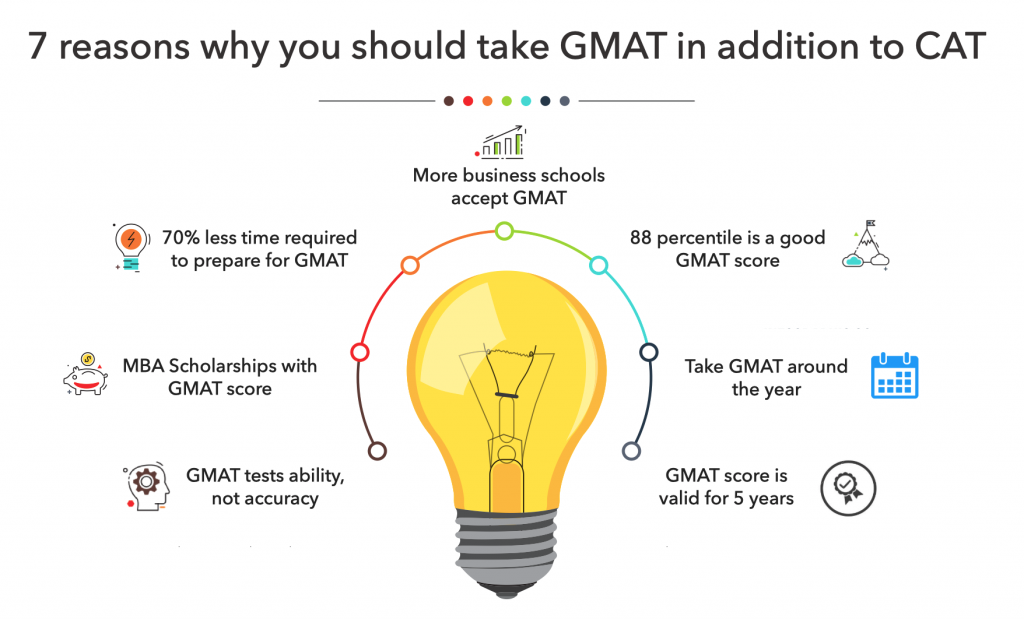
- Take GMAT around the year – GMAT can be taken all year round, unlike CAT which can be taken only once a year. It gives you flexibility in terms of preparing for GMAT.
- More business schools accept GMAT – GMAT is accepted by more than 7000 MBA programs across the globe whereas 130 MBA programs in India accept CAT. There are a few Indian business schools which accept GMAT scores for their full-time MBA programs. You can find out more about these business schools in this article on the scope of GMAT in India.
- Get MBA scholarships for your GMAT score – Top 25 US business schools currently hand out scholarships worth $230 million. In fact, in 2018 Harvard Business School alone awarded $36 million worth of scholarships.
Prawee scored a 740 on the GMAT and received admit from 4 business schools including Kellogg School of Management. She also received cumulative scholarships worth $180,000. Learn what is a good GMAT score for MBA scholarships.
- 70% less time is taken to prepare for GMAT – Time required to prepare for the GMAT is significantly lower than CAT. A typical student spends 10-12 months preparing for the CAT. However, you can score a 700+ score on the GMAT with 2-3 months of preparation.
- 88 percentile is a good GMAT score – A 700+ score is considered a good GMAT score which is 88 percentile. However, a good CAT percentile for MBA admissions is at least 98 percentile.
Anupriya was weak in quant and didn’t perform well in CAT, but she took the GMAT and scored a 760 and got an admit from ISB Hyderabad.
- GMAT is valid for 5 years – GMAT is valid for 5 years while CAT is valid for one year. You can take the GMAT and then focus on building your profile for MBA admissions. Moreover, with a GMAT score, you gain the flexibility of choosing when to participate in the MBA admissions process.
- An adaptive test does not penalize harshly for mistakes – GMAT is an adaptive test which focuses on your ability rather than accuracy. Your score will depend not on the number of correct answers but on the difficulty level of your correct answers. Therefore, GMAT is more of an indicator of your ability and CAT is more of an indicator of your test-taking skills.
These are some of the advantages of taking the GMAT for MBA admissions. If you are someone who has prepared for the CAT and are wondering if your CAT preparation will help you in preparing for the GMAT, the answer is yes.
In the next section, we’ll compare the different sections of CAT and GMAT to find out how much your CAT preparation will aid your GMAT preparation.
If you are planning to take the GMAT, we can help you with a personalized study plan and give you access to quality online content to prepare. Write to us at acethegmat@e-gmat.com.
We are the most reviewed GMAT prep company on gmatclub with more than 1960 reviews.
Why don’t you take a free trial and judge it for yourself?
Will CAT preparation be helpful in GMAT preparation?
First, take a look at the different sections of CAT and GMAT. The purpose is to see if there are any stark differences in the format. For GMAT, only Verbal and Quant section scores are counted towards the overall score. The maximum GMAT score is 800. Take a look at this article to understand the format of the GMAT in detail.

Differences – You won’t find any writing assessment on the CAT, but GMAT asks you to analyze an argument and write an essay in the AWA section. At a sub-section level, CAT Verbal does not have Critical Reasoning questions.
Similarities – Both CAT and GMAT test your quantitative ability, verbal ability, and reasoning ability. Time per question is almost similar for both exams.
|
GMAT |
|||
| Section | Number of questions | Duration (min) | Time per question |
| Quant | 31 | 62 | 2 |
| Verbal | 36 | 65 | 1.8 |
| AWA (Analytical Writing Assessment) | 1 | 30 | 30 |
| IR (Integrated Reasoning) | 12 | 30 | 2.5 |
|
CAT |
|||
| Section | Number of questions | Duration (min) | Time per question |
| Quantitative Aptitude | 34 | 60 | 1.8 |
| Verbal Ability and Reading Comprehension | 34 | 60 | 1.8 |
| Data Interpretation and Logical Reasoning | 32 | 60 | 1.9 |
In the next section, we have explained how the four sections of the GMAT differ from CAT and on which sub-sections of quant (PS or DS) and verbal (SC, CR or RC) you should focus.
Quant section of the GMAT

GMAT Quant has two sub-sections – Problem-solving and data sufficiency. Both these sub-sections cover similar topics from CAT. Statistics is probably one topic that is not covered in CAT.
The difficulty level of CAT Quant questions is several notches higher as compared to GMAT.
However, there is an exception. On the GMAT, the data sufficiency questions are tougher and in most cases the difference between Q50 and Q51. Therefore, you should focus on this sub-section of GMAT quant.
Therefore, we can conclude that CAT preparation will definitely help you in the GMAT quant section and will require less time to cover.
Verbal section of the GMAT
This section’s counterpart on the CAT is the VA-RC section. The verbal section of the GMAT is different from that of CAT. GMAT verbal has three sub-sections – Sentence Correction (SC), Critical Reasoning (CR), and Reading Comprehension (RC).
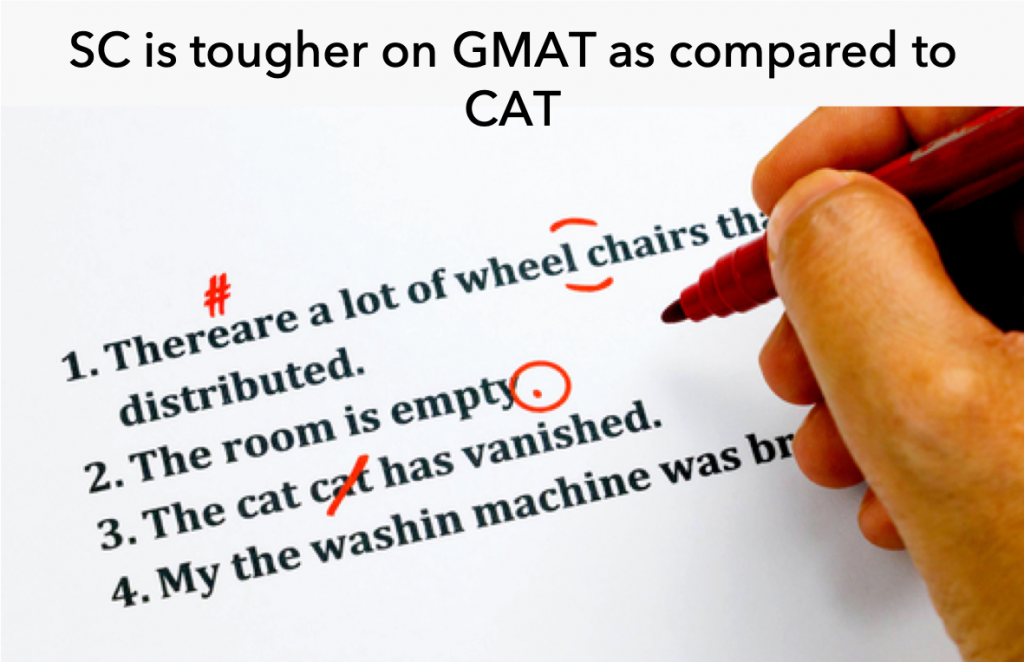
Sentence Correction – SC is tougher on the GMAT as compared to CAT. The topics tested are similar, but the focus of the questions is different. GMAT SC questions are meaning-based as compared to CAT questions which are more focused on grammar and vocabulary. If you have prepared for CAT grammar, then it would have built your GMAT SC foundation, but you would still require more preparation.
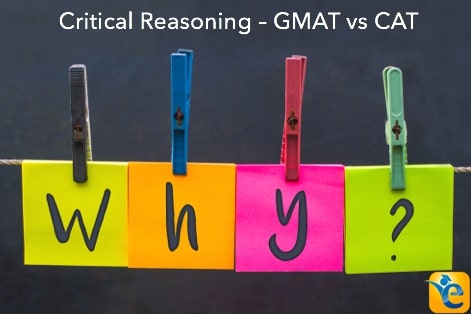
Critical Reasoning – The level of CR questions in CAT is on the lower side. Two or three questions are asked (if any) on the basis of assumptions and inferences. CR in GMAT is more evolved. There will be 10+ CR questions among the 34 verbal questions asked on the GMAT.
In a CR question, you will be given an argument based on an elaborate framework of premise, conclusion, reasoning, assumption, and inference. A question will follow this argument. Therefore, CR sub-section of the GMAT Verbal will be one you’ll need to put in the maximum effort even after preparing for CAT.
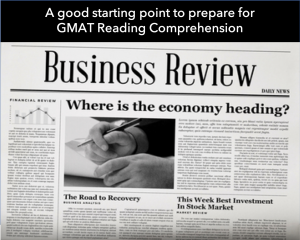
Reading Comprehension – Your CAT preparation will be the most helpful for this sub-section. The level of questions is similar in both GMAT and CAT. The only difference between the RC of CAT and GMAT is that GMAT tends to cover a diverse set of topics and American English is preferred. Therefore, reading content published by American Organizations will be helpful.
Integrated Reasoning
The IR section tests your ability to analyze and interpret data in the form of charts and tables. The difficulty level of this section is less as compared to the LRDI section of CAT. Therefore, the IR section will not require much preparation. Take a look at this article to learn how the GMAT IR section is scored.
The IR section is not counted towards your overall GMAT score.
Analytical Writing Assessment

The AWA section is also not counted towards the overall GMAT score. However, you should not ignore this section because a similar section is not on the CAT. This section asks you to evaluate an argument. The purpose is to see how articulate and analytical are you. You’ll have to prepare for this section from scratch. But, it won’t take more than 10 hours to prepare for this section.
Take a look at this article on ‘how to score a perfect 6 on GMAT AWA’ to learn the best practices of writing an essay.
Time required to prepare for GMAT if you have already taken CAT
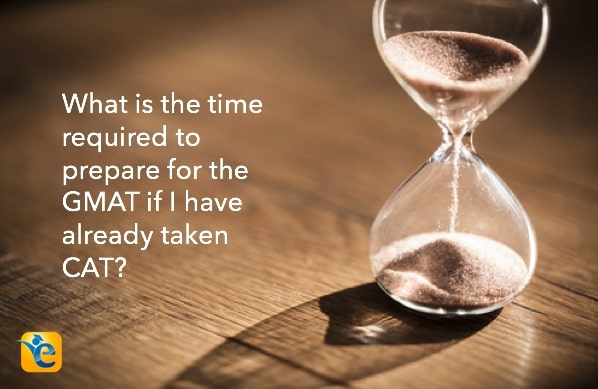
We have already stated that preparing for the GMAT takes about 2-3 months. But the actual amount of time will depend on your current level of preparation.
To understand your current level of preparation, we’ll consider your CAT percentile. However, to know a more precise current GMAT ability level, we’ll recommend you take a diagnostic test.
Here is a free GMAT Verbal Diagnostic test and the GMAT Quant diagnostic test.
Let us take 3 examples to understand the amount of time you’ll require to prepare for the GMAT after having prepared for CAT. For these examples, we have suggested a combination of Learn – Refine method, depending on your CAT percentile
95+ percentile in CAT
If you were able to secure more than 95 percentile in CAT, it means you have good conceptual knowledge, and you are pretty good in applying those concepts.
Focus points of GMAT preparation
In this case, for GMAT verbal section you should focus on learning and refining SC and CR, and refining RC. As far as GMAT quant is concerned, you’ll have to revise the concepts and work on refining the application process.

According to our estimate, you’ll require somewhere between 90 and 120 hours of preparation. (this time can reduce depending on your level of preparedness for GMAT quant) If you dedicate 20 hours per week (2 hours per day on weekdays and 5 hours per day on weekends), then you can finish preparing for the GMAT in 5 to 6 weeks, i.e. 1.5 months. The breakup of the time required is as follows:
| Quant Section | Required hours | Verbal Section | Required hours | |
| Refine Number Properties | 5 hours | Learn SC | 25 hours | |
| Refine Algebra | 5 hours | Refine SC | 20 hours | |
| Refine Geometry | 5 hours | Learn CR | 30 hours | |
| Refine Word Problems | 5 hours | Refine CR | 10 hours | |
| Refine Advanced Problems | 5 hours | Refine RC | 10 hours |
88 – 94 percentile in CAT
This percentile group is the trickiest when it comes to estimating the GMAT preparation time. Why? Because CAT takers in this group do not have a balanced QA, VARC and LRDI percentiles. Many would score above 95 percentile in two sections but less than 80 percentile in one section. So, the time estimate will be highly personalized for people in this category.
If you are someone who scored between 90-94 percentile, then we can safely assume that you are above average in either quant or verbal. Let’s take 3 cases and decide how much time will be required in each case.
Case 1 – QA (>85 percentile), VARC (<90 percentile)
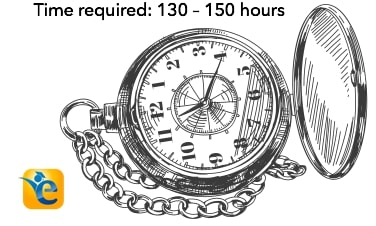
If you scored less than 85 percentile in QA and above 90 percentile in VARC, then you’ll have to learn weak concepts of Quant and refine your application process. This section will take 40-50 hours to complete. For GMAT verbal, you’ll need to learn – refine SC and CR, and refine RC. This will take 90-100 hours to complete. In total, you’ll require 130 – 150 hours to prepare.
Case 2 – QA (<90 %ile), VARC (<85 %ile)
If you scored above 90 percentile in QA and less than 85 percentile in VARC, then for quant section you’ll just have to refine your application process. This section will take 25-30 hours to complete. For GMAT verbal, you’ll need to learn – refine SC and CR, and refine RC. This section will take 100-110 hours to complete. In total, you’ll require 120 – 140 hours to prepare for the GMAT.
Case 3 – QA (85-90 %ile), VARC (85-90 %ile)
If you scored between 85 and 90 percentile in both QA and VARC, it means you are average in both sections. You’ll have to learn and refine both quant and verbal sections. To complete your preparation, you’ll require 40-50 hours for quant, and around 100 hours for verbal.
If you dedicate 20 hours per week (2 hours per day on weekdays and 5 hours per day on weekends), then you can finish preparing for the GMAT in 7-8 weeks, i.e. 2 months.
Less than 87 percentile in CAT
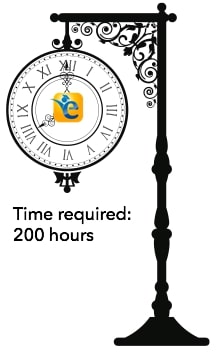
If you scored less than 87 percentile in CAT, we can assume you are below average in both quant and verbal sections. There will be very few people with a disparity between quant (QA) and verbal (VA-RC) percentiles.
So, if you fall into this category, you’ll have to learn and revise both the quant and verbal sections. According to our estimate, your GMAT preparation will take 200 hours.
If you dedicate 20 hours per week (2 hours per day on weekdays and 5 hours per day on weekends), then you can finish preparing for the GMAT in 10 weeks i.e. 2.5 months
Therefore, in any case, you’ll not require more than 3 months to prepare for the GMAT even if you performed below average in CAT.
If you are planning to take the GMAT, we can help you with a personalized study plan and give you access to quality online content to prepare. Write to us at acethegmat@e-gmat.com.
We are the most reviewed GMAT prep company on gmatclub with more than 1960 reviews .
Why don’t you take a free trial and judge it for yourself?
Takeaways – GMAT in addition to CAT
GMAT has many benefits as compared to CAT when it comes to MBA admissions. Moreover, you can easily leverage your CAT preparation to prepare for the GMAT.
- GMAT gives you the flexibility of choosing your MBA application year without worrying about taking any standardized test every year as the score is valid for 5 years.
- GMAT judges your ability level rather than your test-taking skills. If you are someone whose concepts are strong, but somehow you are not strategic enough about test taking then GMAT is the right test for you.
- A 700+ score (88+ percentile) is considered a good GMAT score for admissions as compared to 98+ percentile which is a good CAT score. For example, 709 is the average GMAT score of the incoming class of ISB. If you score a 720, then it’ll be a very competitive score for ISB admissions. GMAT 720 is 94 percentile.
- A good GMAT score maximizes your chances of getting a scholarship. Who wouldn’t want to study for free at a top business school?
- CAT Quant is tougher than GMAT Quant. Therefore, preparing for the GMAT quant won’t be a difficult task.
- GMAT verbal is different from CAT verbal section. GMAT verbal focuses on meaning whereas CAT verbal focuses on grammar and vocabulary. Also, GMAT verbal has a Critical Reasoning sub-section which asks a higher number of difficult questions on CR.
- Even if you performed average on the CAT, preparing for the GMAT won’t take more than 3 months. This time would reduce to 2 months if you scored above 90 percentile in CAT.















